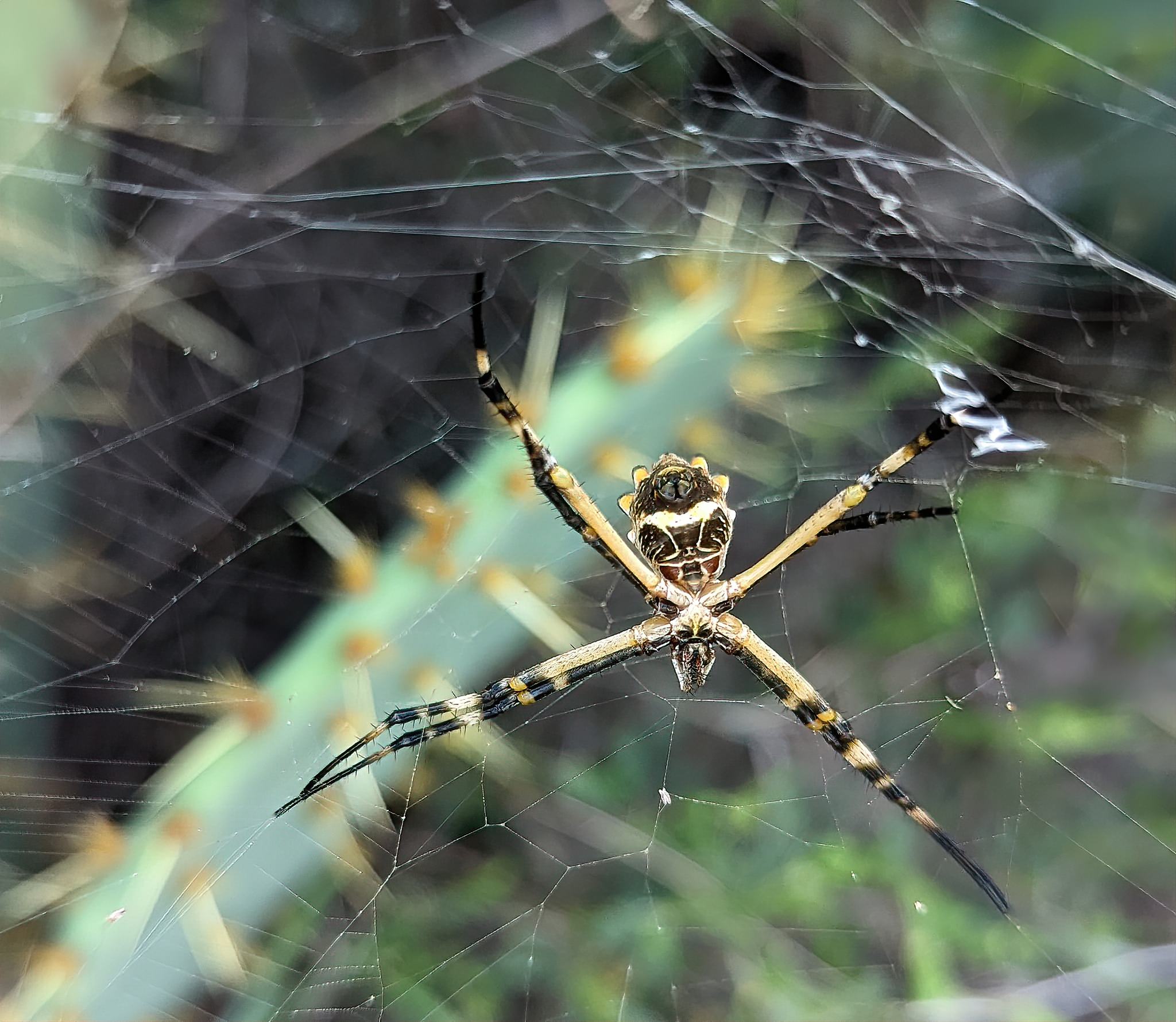by M. Kathy Raines
Like a bejeweled gymnast, the Silver Garden Spider lay with paired legs forming an upside down “x”, its web hammocked between pads of a prickly pear cactus.
Unphased by peering eyes and camera, she awaited a change—a vibration signaling that her silk had entrapped an unwitting butterfly or moth. Like a skilled angler fishing without a bobber, she can detect what kind of prey—or ardent male—awaits her. Then, she goes to work, paralyzing her victim with a long or short bite and wrapping it in silk before dining on it.

Spotting a Silver Garden Spider— its web slung between prickly pear pads along the Brownsville Historic Battlefield Trail—is as lovely as viewing a hovering White-tailed Kite or perched Harris’s Hawk scouting for rabbits and rodents. An ornate little beast, its cephalothorax, or fused head and thorax, shine silver or white, and its abdomen is orangish yellow with black spines. Black or brownish bands decorate the ends of its orangish legs. While females are about 1.3 inches long, males, about 30% smaller, can reach about 0.7 inches.
The Silver Garden Spider or Silver Argiope (Argiope argentata), whose Latin names mean “silver” and “silvered”, respectively, thrives in the southern United States down to South America. Locally, it frequently weaves its low web within cacti, whose spines may offer protection from predators, but it inhabits other plants, too.
Along with fellow orb weavers in the family Araneidae (Latin for spider web), the Silver Garden Spider constructs an elaborate, wheel-like web, emitting a variety of silk—some sticky, for capturing insects, and some dry for walking on. The silk is initially a liquid stored in silk glands, which the spider taps into with spigot-equipped spinnerets on its abdomen.
Unlike our common Tropical Orb Weaver, which constructs a new web every night and eats it in the morning, the Silver Garden Spider, which is active both day and night, creates a web that lasts a few days, thus conserving time and energy. A female’s slightly tilted web may be two feet in diameter. The smaller male may build his lesser web nearby.
Both the garden spider’s shiny body and its web reflect ultra-violet light, likely confusing predators into thinking they are flowers to pollinate. Also, it weaves stabilimenta—concentrated, patterned silk resembling zig-zags—into its web. Their purpose, originally thought to be to provide stability—a theory partially put to rest when researchers discovered that cutting them out made no difference—is a mystery. Since this spider does not rebuild its web daily, these designs may both confuse predators and prevent birds from crashing into and destroying it. Stabilimenta also reflect insect-attracting light.

The cannibalistic female emits pheromones which prompt a nearby male to pull on a mating thread she produces. If she’s receptive, the male jumps upon her, using copulatory organs, pedipalps, near his head, which transfer sperm to her organ, the epigyne. After a few seconds, he lets go, and, unless he escapes or mates with her again, she bites and immobilizes him, then wraps him in silk and eats him, providing added nourishment for her soon-to-be-born spiderlings. If uneaten, he usually dies shortly afterwards. After mating, parts of his sexual organs break off, plugging her so that others do not mate with her, thus perpetuating his genetic material. A female produces—from the same silk as her web—a greenish egg sac, which hangs from her web. Spiderlings, instinctively communal, amass till maturity and dispersion.
Being toothless, this spider, like others, produces juices that transform its victims into an easily slurped soup. Dew stuck to its web provides drinking water.
Snakes, lizards and birds eat Silver Garden Spiders, which live short lives. Also, wasps collect them to nourish their larvae. Benefitting from the garden spiders’ poor vision, small Dewdrop Spiders sometimes inhabit their webs and, undetected, steal their prey. Interestingly, some years, silver garden spiders face a sudden decline, almost to extinction, and then revive.

With their consumption of agricultural pests and mosquitoes, Silver Garden Spiders—besides being decorative and interesting— provide a valuable service.

